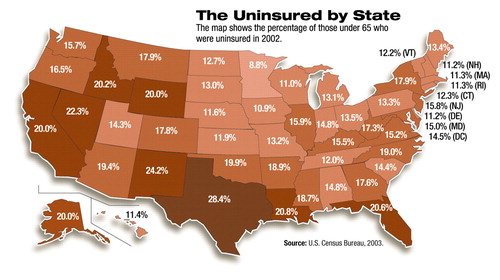IOM Says Small Steps Won’t Cure Health Insurance Crisis
 The lack of health insurance in many American communities is a problem that can no longer be ignored, and the federal government can and should seek to achieve universal health coverage by 2010.
The lack of health insurance in many American communities is a problem that can no longer be ignored, and the federal government can and should seek to achieve universal health coverage by 2010.
So says a 16-member committee of the Institute of Medicine (IOM) in a recent report, “Insuring America’s Health: Principles and Recommendations.” In keeping with the title, the report outlines principles for achieving universal coverage and describes prototypical strategies for reform.
No matter what strategy is chosen, the problem requires a federal solution, and incremental fixes are no longer sufficient, concludes the Committee on the Consequences of Uninsurance. The committee includes health and public policy experts from the public and private sectors.
“The persistence of sizable uninsured populations in many communities in the United States has important local effects,” according to the report. “These include (1) significant financial strain on health care providers and institutions that can lead to loss of valuable community resources, such as a trauma center or physician practices, and (2) redirection of funds to the uninsured away from core public health programs that address control of diseases and emergency preparedness.”
The report also emphasizes, “The economic vitality of the nation is limited by the poorer health, premature death, and long-term disability of uninsured workers. The value in health years of life gained by providing coverage to everyone would almost certainly be greater than the additional cost of providing health care, at the level of the currently insured, to those who lack coverage.”
The IOM also states that incremental improvements—from the Medicare and Medicaid programs enacted in the 1960s to serve elderly and needy populations, to the State Children’s Health Insurance Program (SCHIP) enacted in the 1990s—have not closed the gap in coverage or addressed underlying problems in the nation’s patchwork of public and private health care networks.
Committee co-chair Mary Sue Coleman, president of the University of Michigan, stressed the importance of federal involvement. “Lack of health insurance in the United States is a critical problem that can and should be eliminated,” she said. “Achieving universal coverage will require federal leadership and support, regardless of which strategy is adopted to achieve this goal.”
The report, the sixth from the IOM in a series of reports on the nation’s health care system, includes five principles to guide health reform strategies and outlines four prototypical reform strategies—discussing each strategy with respect to how well it addresses the five principles.
The five principles are that health care coverage should be universal, continuous, affordable to individuals and families, and affordable and sustainable to society and should enhance health and well-being by promoting access to high-quality care that is effective, efficient, safe, timely, patient-centered, and equitable.
The principles are based on evidence and conclusions reached in the committee’s five previous reports, which documented the consequences of lack of health insurance. Among those consequences are the following:
• About 18,000 unnecessary deaths occur each year due to a lack of health insurance.
• Only half of uninsured children visited a physician during 2001, compared with three-quarters of insured children. Lack of regular care can result in more expensive care for preventable or treatable conditions, and disruptions in learning and development.
• When even one family member is uninsured, the entire family is at risk for the financial consequences of a catastrophic illness or injury.
• Tax dollars paid for an estimated 85 percent of the roughly $35 billion in unreimbursed medical care for the uninsured in 2001.
The IOM report also describes four prototypical strategies for reform. Each has strengths and weaknesses, and the ideal strategy may be one that combines the strengths of all of them; but any of the strategies would be better than the status quo, according to the report.
These are the four prototypes:
• Major public-program expansion and new tax credits. Under this strategy, favorable tax treatment for employer-based private insurance would remain in place. Medicaid and SCHIP programs would be combined, and Medicare would be extended to 55-year-old individuals who pay a premium. Tax credits would allow moderate-income individuals to purchase private insurance.
• Employer mandate, premium subsidy, and individual mandate. Employers would be required to offer coverage and contribute to premiums, with a federal subsidy for employers of low-wage workers. Medicaid and SCHIP would be merged, and Medicare would remain as is. Individuals would be required to obtain coverage through employers, enrollment in a public program, or private purchase.
• Individual mandate and tax credit. Individuals would be required to buy health insurance for themselves and their families on the open market, supported by a federal tax credit. Medicaid and SCHIP would be eliminated, but Medicare would remain as is.
• Single payer. Everyone would be enrolled in a single, comprehensive benefit package, though individuals could purchase supplemental policies for noncovered services. The program would be administered by the federal government, but contractors and private health plans would review claims and process payments, as is now the case with Medicare. A “global budget” would be established. While Medicaid and SCHIP would be eliminated, Medicare enrollees would be folded into the new federal plan.
“Insuring America’s Health: Principles and Recommendations” is posted online at www.iom.edu/report.asp?id=17632. ▪



